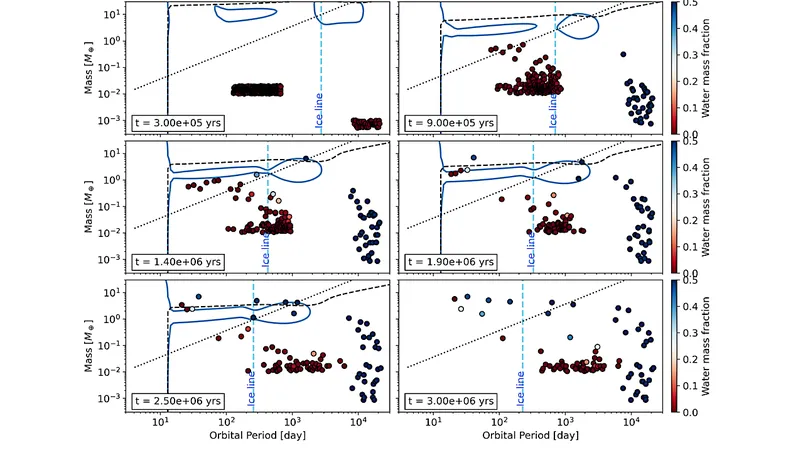
Unveiling the Secrets of Planet Formation: Super-Earths and Mini-Neptunes!
2025-01-08
Author: John Tan
Introduction
Recent studies on the solar system's formation have illuminated the fascinating pathways that planets take in their development. It's been proposed that terrestrial and giant planets formed from material rings situated at ~1 astronomical unit (AU) and ~5 AU from the Sun, respectively. But what about the emerging class of exoplanets known as super-Earths and mini-Neptunes?
Formation Mechanisms
Exciting new simulations highlight that these two types of planets may share a strikingly similar formation process. Conducted with a disk alpha-viscosity of 0.004, the simulations reveal that super-Earths coalesce from rings of rocky materials in the inner disk, primarily through the accretion of planetesimals. On the other hand, mini-Neptunes predominantly emerge from rings located beyond the water snowline, utilizing a process known as pebble accretion to grow.
Observational Alignments
These innovative simulations notably align with several distributions observed in exoplanets—these include the period-ratio, intra-system size uniformity, and planet multiplicity distribution. Intriguingly, the existence of a "radius valley," a gap in the size distribution of exoplanets, suggests that the typical mass available for rocky planet formation is constrained to less than 3-6 Earth masses.
Predictive Insights
The predictions from these findings indicate that planets situated at ~1 AU in systems harboring close-in super-Earths and mini-Neptunes will likely be water-rich. Although such systems are relatively rare—occurring about 1% of the time—they may also include rocky Earth-sized planets within the habitable zone. Some of these planets possibly underwent late giant impacts, resembling the event that led to the Moon's formation.
Visualizing Planet Formation
To visualize this complex process, imagine a schematic diagram where planetesimals form at different locations within the disk, closely linked to the sublimation and condensation lines of silicates and gaseous water. Notably, planetesimals and pebbles hold distinct compositions based on their locations within inner and outer rings. In the inner ring, planetesimal accretion is the predominant growth mechanism, while in the outer ring, pebble accretion takes precedence.
Dynamics of Planet Migration
As planetesimals grow larger, they tend to migrate toward the inner regions of the disk, establishing resonant chains anchored at the edge of the disk. However, as the gas disk disperses, these resonant chains are disrupted, leading to massive collisions that ultimately shape planetary atmospheres and trigger orbital reconfigurations.
Conclusion
These groundbreaking revelations about the formation and characteristics of super-Earths and mini-Neptunes are poised to influence our understanding of planetary systems not just in our own solar system, but across the universe. The ongoing exploration of these cosmic phenomena could soon answer some of the most pressing questions regarding the existence of potentially habitable worlds beyond Earth.
Stay tuned as researchers delve further into the secrets of planetary formations, revealing the mysteries of our cosmic neighborhood!
 Brasil (PT)
Brasil (PT)
 Canada (EN)
Canada (EN)
 Chile (ES)
Chile (ES)
 Česko (CS)
Česko (CS)
 대한민국 (KO)
대한민국 (KO)
 España (ES)
España (ES)
 France (FR)
France (FR)
 Hong Kong (EN)
Hong Kong (EN)
 Italia (IT)
Italia (IT)
 日本 (JA)
日本 (JA)
 Magyarország (HU)
Magyarország (HU)
 Norge (NO)
Norge (NO)
 Polska (PL)
Polska (PL)
 Schweiz (DE)
Schweiz (DE)
 Singapore (EN)
Singapore (EN)
 Sverige (SV)
Sverige (SV)
 Suomi (FI)
Suomi (FI)
 Türkiye (TR)
Türkiye (TR)
 الإمارات العربية المتحدة (AR)
الإمارات العربية المتحدة (AR)